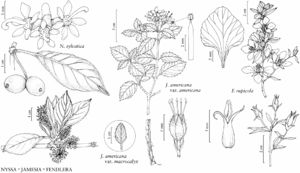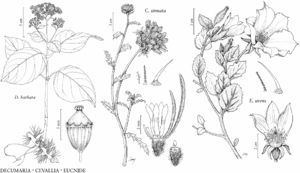Subshrubs, shrubs, trees, or vines [herbs], evergreen or deciduous. Leaves usually opposite, sometimes whorled [alternate], simple; stipules absent; petiole present or absent; blade sometimes palmately lobed, margins entire, serrate, serrulate, dentate, denticulate, or crenate; venation pinnate or acrodromous (Fendlera, Fendlerella, Philadelphus, Whipplea). Inflorescences terminal or axillary, cymes, panicles, racemes, or corymbs, or flowers solitary. Flowers bisexual [unisexual], or sometimes marginal ones sterile, radially symmetric (bisexual ones) or bilaterally symmetric with enlarged petaloid sepals (sterile ones); perianth and androecium nearly hypogynous, perigynous, or epigynous; hypanthium completely adnate to ovary or adnate to ovary proximally, free distally; sepals 4–12, distinct or connate basally; petals 4–12, connate basally [entirely, then calyptrate]; nectary usually present, rarely absent; stamens 8–200, usually distinct, sometimes connate proximally, free; anthers dehiscing by longitudinal slits; pistil 1, 2–12-carpellate, ovary less than 1/2 inferior, 1/2 inferior, or completely inferior, 1–12-locular, placentation usually axile proximally, parietal distally, rarely strictly axile or parietal; ovules 1–50 per locule, anatropous; styles 1–12, distinct or connate proximally to most of length; stigmas (1–) 2–12. Fruits capsules [berries], dehiscence septicidal, loculicidal, interstylar, or intercostal. Seeds 1–50 per locule, funicular appendage present (Fendlerella, Whipplea) or absent.
Distribution
North America, Mexico, Central America, South America, Eurasia, Pacific Islands
Discussion
Genera 17, species ca. 240 (9 genera, 25 species in the flora).
A. Cronquist (1981) placed Hydrangeaceae among a group of woody families traditionally allied with Saxifragaceae. Phylogenetic studies consistently place Hydrangeaceae in the Cornales and sister to Loasaceae (A. L. Hempel et al. 1995; D. E. Soltis et al. 1995; L. Hufford et al. 2001; Hufford 2004). Within Hydrangeaceae, the western North American genera Fendlera and Jamesia form a clade (subfam. Jamesioideae L. Hufford) that is sister to the rest of the family (subfam. Hydrangeoideae Burnett) (Hufford et al.; Hufford). Subfamily Hydrangeoideae comprises two tribes: Philadelpheae de Candolle ex Duby and Hydrangeeae de Candolle. North American genera in the former are Carpenteria, Deutzia, Fendlerella, Philadelphus, and Whipplea. A molecular phylogenetic study by Y. De Smet et al. (2015) clarified relationships within Hydrangeeae, found Hydrangea to be polyphyletic, and promoted adoption of a broader concept of Hydrangea that includes the eight other genera in the tribe. The two North American genera in the tribe, Decumaria and Hydrangea, are circumscribed here in their traditional senses.
The Hydrangeaceae are well represented in the paleobotanical record dating back to the Upper Cretaceous but best represented in the Tertiary (L. Hufford 2004). Some genera are sources of popular introduced or native ornamentals, including Carpenteria, Deutzia, Hydrangea, and Philadelphus. Some ornamentals have become established outside of cultivation in the flora area. A few North American Hydrangeaceae have reputed medicinal (D. E. Moerman 1998) or toxicologic (G. E. Burrows and R. J. Tyrl 2001) properties.
Trichomes in most Hydrangeaceae consist of a long, unicellular portion, often borne on a multicellular base. The unicellular portion often bears tubercles on its surface. Sometimes instead of tubercles, it bears long extensions, making the trichome appear branched or dendritic. Such trichomes are here referred to as branched.
Selected References
Lower Taxa
Illustrations
Key
| 1 | Woody vines. | Decumaria |
| 1 | Subshrubs, shrubs, or trees. | > 2 |
| 2 | Twigs with stellate and simple trichomes. | Deutzia |
| 2 | Twigs glabrous or with simple or, sometimes, branched trichomes, never with stellate trichomes. | > 3 |
| 3 | Flowers both sterile and bisexual. | Hydrangea |
| 3 | Flowers all bisexual. | > 4 |
| 4 | Stamens (11–)13–90 or 150–200. | > 5 |
| 5 | Sepals 4; petals 4 (or 8+ in some horticultural forms); ovaries inferior to 1/2 inferior, 4-locular; styles 1 or 4; leaves deciduous; stamens (11–)13–90. | Philadelphus |
| 5 | Sepals 5–7; petals 5–7(–8); ovaries nearly superior, 5–7-locular; styles 1; leaves persistent; stamens 150–200. | Carpenteria |
| 4 | Stamens 8–12. | > 6 |
| 6 | Stems prostrate to decumbent. | Whipplea |
| 6 | Stems erect, ascending, or spreading. | > 7 |
| 7 | Filament apices 2-lobed, lobes prolonged beyond anthers; seeds (1–)2–4(–6) per locule. | Fendlera |
| 7 | Filament apices not 2-lobed; seeds 1 or 10–50 per locule. | > 8 |
| 8 | Inflorescences 100–1000-flowered; capsule dehiscence interstylar, creating pore at base of styles. | Hydrangea |
| 8 | Inflorescences 1–35-flowered; capsule dehiscence septicidal. | > 9 |
| 9 | Leaf blade margins usually crenate to dentate, rarely entire; blades ovate or broadly ovate to obovate, rhombic, or suborbiculate, venation pinnate; seeds 25–50 per locule. | Jamesia |
| 9 | Leaf blade margins entire; blades elliptic to lanceolate, oblanceolate, obovate, or linear-oblong, venation acrodromous; seeds 1 per locule. | Fendlerella |
"connate" is not a number. "distinct" is not a number.



